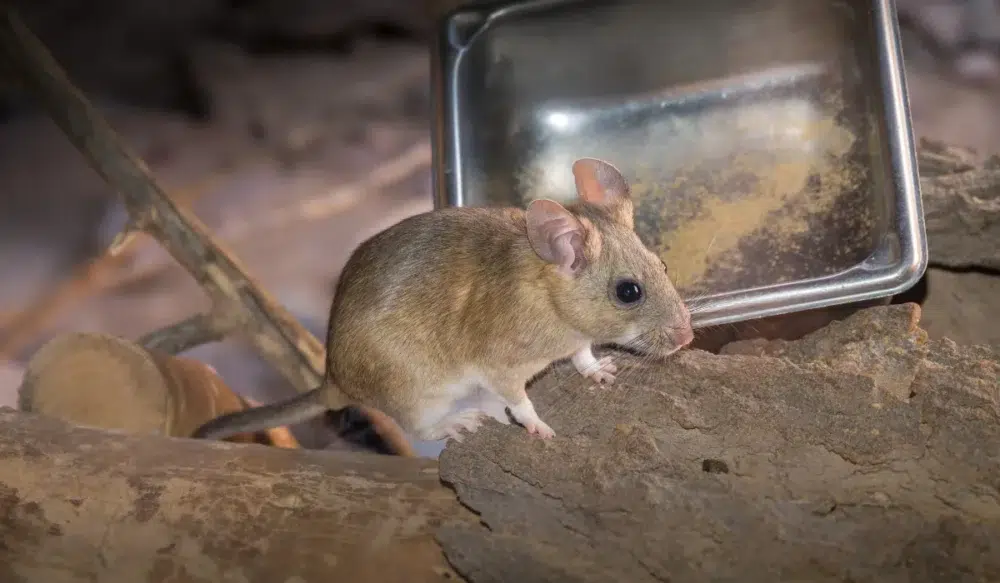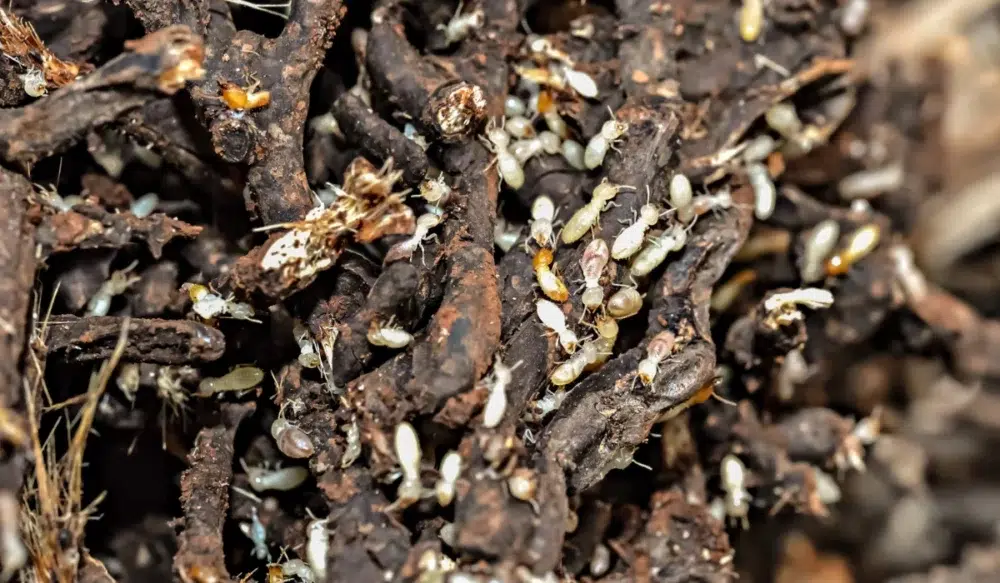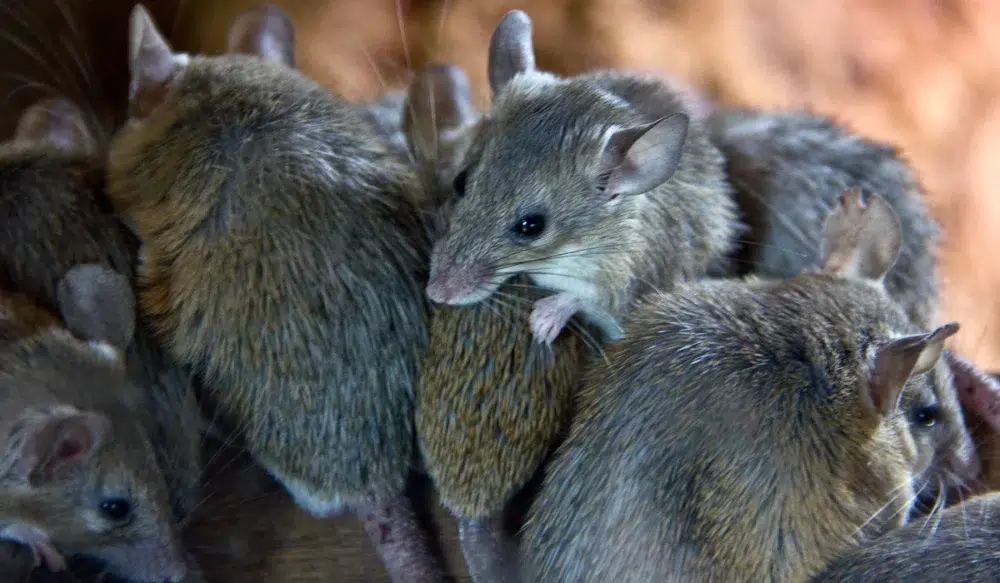Termites cost American homeowners billions of dollars in repair bills each year. In most areas of the country, Americans deal with termite intrusions during the warm part of the year or termite season; but living in the hot and dry climate of Arizona, we must be vigilant against these little engines of wood destruction all year long.
Unlike most other pests you might encounter trying to make your home their own, termites have no interest in the comforts of your home or the contents of your pantry. They’re here to attack the structure of the house itself.
Termites feed on cellulose, utilizing a complicated process involving symbiotic bacteria in their stomachs to extract nutrients from wood fibers. Once they make their way into your home, termites get busy tunneling through the wooden members of the walls, floors, and roof, eventually causing costly and hard-to-repair damage.
Termites are often confused with relatively harmless ants since both live in large, well-organized colonies and are similar behaviorally. Carpenter ants, in particular, hold multiple similarities to termites, like being very alike in size, color, and penchant for tunneling through the wood.
Termite colonies are usually much bigger, often numbering up to half a million members, which are split into casts and centrally controlled. They center around a queen capable of laying many thousands of eggs per day (compared to less than 800 maximum for an ant queen). Most of the nest members are worker and soldier termites, incapable of reproduction and tasked with feeding and protecting the queen and immature termites.
Once the numbers in the nest grow large enough that it becomes difficult to support them, the queen produces a new cast, the reproductives. Reproductives are the termites you see swarming around the area after late spring and early summer rains. Their singular purpose is to find a suitable spot and establish a new colony. Reproductives, or swarmers, are also often confused with ant swarmers since they have very similar habits and are similar in appearance. The easy way to differentiate termite swarmers from ants is to take a look at their wings. Ant swarmers have a large pair of wings followed by a much smaller rear set. Termite swarmers have four wings equal in size.
There are thousands of termite species around the world, but in Arizona, you’re likely to run into the following:
Subterranean termites are the hardest to spot and are responsible for more damage than any other type of termite. They tunnel into structures from underground and, once there, can remain unnoticed for years, all the while tunneling through joists and beams and weakening the structural integrity of your house. Subterranean termites are usually around 1/8 of an inch long with long, narrow, oval bodies that are creamy white to dark brown.
Dampwood termites, as the name suggests, are not fans of dry wood and are usually found in wood with high moisture content. Our homes are built from dry lumber to avoid twisting and shrinking, making them less attractive to this termite species. If there is access to water from leaking plumbing, condensation in unventilated basements, or crawl spaces, dampwood termites will infest your home. Dampwood termites are between 3/8 and 5/8 of an inch long, with white to brown bodies that are narrow and elongated in shape. Dampwood termite nests differ in the organization from other termite species by utilizing immature termites to do the jobs usually assigned to worker and soldier casts.
Drywood termites are the largest of the three common species you’re likely to encounter around Phoenix, growing up to an inch long. They have long, narrow bodies that are creamy white to dark brown and live in relatively small colonies, rarely numbering more than 2,000 members. Drywood termites are fond of eating wood with low moisture content making the lumber that holds up our homes their favorite snack. Add to that their habit of building large chambers across the grain in the lumber they’re tunneling through, and it’s clear why this is the most feared species of termite by most homeowners.
Termite infestations often go unnoticed for months, if not years, so let’s take a quick look at signs of termite damage to watch for, a few easy termite prevention tips, the basics of termite removal, and if prevention fails, how to find experienced pest control in Phoenix.
What Does A Termite Infestation Look Like?
The biggest problem with a termite infestation in your home (besides the costs to repair it) is how difficult it is to spot the signs of an infestation before the colony is huge and does serious damage. Termites live either under the ground or inside lumber itself, some of which may be in our walls and floors. They do not make noise as they tunnel through wood, and while a single insect is not likely to do significant damage, a colony of hundreds of thousands definitely will.
For a DIYer, the only reliable way to deal with a termite problem is to catch it in the very early stages before the numbers in the colony grow.
Some signs of termites in your home include:
Seeing termite swarmers after spring or summer rains.
Finding shed swarmer wings around window sills and doorways.
Finding small piles of sawdust called termite frass by the entrances to their tunnels.
Seeing blistered paint and bulging wood surfaces.
Finding wood that sounds hollow if you knock on it.
Finding wood covered in small round holes that are the entrances to termite tunnels.
For each termite, you are likely to spot there are thousands hidden within the walls and the nest itself. If you’re seeing signs of termite infestation, getting a professional termite control service in Phoenix involved as soon as possible is imperative to avoid them causing further damage to your home.
The Extent Of Structural Damage Termites Can Create To Your Home
A single termite will consume over 20 % of its weight in cellulose daily. It does not seem like much, but multiply that number by the hundreds of thousands of members termite colonies hold, and the extent of the damage can be very significant. Structural members supporting the weight of your house rely on cross-sectional strength; termite tunneling will weaken their ability to support weight, and sooner or later, it will result in a catastrophic failure if not stopped.
Natural Termite Prevention Tips For Around The Home
Once termites in Phoenix settle into your home, getting them to move out on your own is pretty much impossible. Termite queens can lay up to 12000 eggs a day, growing the numbers of the colony rapidly. When it comes to termite control, an ounce of prevention is definitely worth a pound of cure, so let’s take a look at what you can do to make your home as unattractive to termites as possible:
Fix leaking plumbing pipes as soon as possible since termites need an environment with high humidity to stay alive.
Don’t allow rain puddles and other standing water to accumulate around the perimeter of your house.
Keep crawl spaces and basements well-ventilated and inspect them for termite presence on a regular basis.
Don’t store firewood next to the walls of your home. Drywood termites are often present in the pieces of firewood and will find their way through the wall, given enough time.
Make sure any wooden pieces of your home’s structure have proper treatment on them if they come in contact with the ground.
Seal cracks in your walls and make sure that doors and window screens fit tightly and in good repair to avoid letting swarmers into your home.
While preventative measures are a great start, if you take into consideration the cost of damage that termites can inflict on your home and how unlikely it is you’ll spot signs of an infestation without relying on previous experience, it might be a good idea to add a yearly termite inspection to your termite prevention strategy.
The Best Form Of Termite Protection For Phoenix Homeowners
At Green Home Pest Control, we’ve been helping Phoenix residents keep their homes free of termites and other pests for over 40 years. Our technicians will start the visit by surveying your property for signs of termites and determining the best strategy to clear them out of your home without endangering your health. We use either a liquid treatment which creates a termite barrier around the periphery of your house, a bait treatment, or, in some cases, a combination of the two. Our treatments are fully guaranteed to clear termites out of your home.
If you’re struggling with a termite infestation in your Phoenix home, get in touch with us for a free inspection today!



